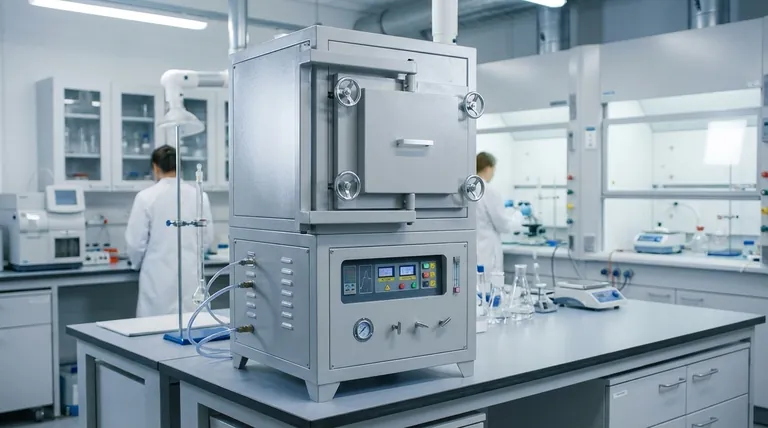In essence, an atmosphere controlled furnace is a specialized piece of thermal processing equipment that allows you to heat a material within a precisely managed gaseous environment. Unlike a standard furnace that operates in ambient air, this system replaces the air with a specific gas—or a mixture of gases—to prevent unwanted chemical reactions like oxidation and enable highly specific material transformations.
The core challenge of high-temperature processing is that heat accelerates chemical reactions, often degrading the material you are trying to improve. An atmosphere furnace solves this by creating a controlled "bubble" of a specific gas around the part, protecting its surface integrity and enabling advanced metallurgical or ceramic processes.

The Core Problem: Why Control the Atmosphere?
A standard furnace simply heats a material in the air around it. For many applications, this is insufficient because the oxygen, nitrogen, and moisture in the air can be destructive at high temperatures.
The Primary Enemy: Oxidation
When metals are heated in the presence of oxygen, they oxidize. This creates a layer of scale or tarnish on the surface, which can ruin the part's finish, alter its dimensions, and compromise its mechanical properties. An atmosphere furnace prevents this entirely.
The Solution: A Controlled Environment
The fundamental principle is to purge the furnace chamber of ambient air and replace it with a controlled atmosphere. This is typically an inert gas like Argon or Nitrogen that will not react with the material, even at extreme temperatures. This ensures the material emerges from the heating process clean and chemically unchanged.
Enabling Advanced Processes
Beyond just prevention, controlling the atmosphere can also be used to intentionally introduce specific elements into a material's surface. Processes like carburizing (adding carbon) rely on a carefully managed, reactive gas atmosphere to achieve a desired change in the material's properties.
How an Atmosphere Furnace Works
While designs vary, the core components and principles are consistent. The system is a synthesis of a high-temperature chamber and a sophisticated gas management system.
The Heating System
Most atmosphere furnaces use electric heating elements, such as resistance wire, to generate heat. This energy is transferred to the object inside primarily through radiation, allowing for highly uniform and predictable temperature distribution throughout the chamber.
The Gas Control System
This is the furnace's defining feature. It includes a system to first purge the oxygen-rich air from the sealed chamber. Then, it introduces the desired gas (e.g., Nitrogen, Argon) from a supply source. The system maintains a slight positive pressure inside the furnace to ensure any leaks flow outward, preventing contaminating air from entering.
The Control and Monitoring System
Modern furnaces rely on integrated control systems to manage the process. These systems precisely regulate temperature according to a pre-set profile and monitor gas flow rates and internal pressure, ensuring the process is repeatable, stable, and safe.
Understanding the Trade-offs and Safety
While powerful, atmosphere furnaces introduce complexities and considerations not present in standard air furnaces.
Increased Complexity and Cost
The need for a perfectly sealed chamber, gas delivery plumbing, pressure sensors, and sophisticated control systems makes these furnaces more expensive and complex to operate than their conventional counterparts.
Critical Sealing and Maintenance
The integrity of the furnace seal is paramount. Any leak compromises the atmosphere, potentially ruining the part and wasting expensive process gas. Regular inspection and maintenance of door seals and gas fittings are essential.
Gas Handling and Safety
Using large volumes of gas, especially inert gases that can displace oxygen in a room, requires strict safety protocols. Furnaces are equipped with pressure relief valves, alarms, and sometimes blast-proof ports to ensure safe operation. Proper ventilation and gas monitoring in the facility are non-negotiable.
Is an Atmosphere Furnace Right for Your Process?
The decision to use an atmosphere furnace comes down to the required outcome for your material.
- If your primary focus is preventing oxidation and discoloration: An atmosphere furnace is essential for achieving a clean, bright finish on metals during processes like annealing or brazing.
- If your primary focus is advanced material processing: For applications like sintering powdered metals or technical ceramics, controlling the atmosphere is non-negotiable to achieve the required density and mechanical properties.
- If your primary focus is simple heating with no surface finish requirements: A less complex and more cost-effective standard air furnace is the appropriate tool for the job.
Ultimately, choosing the right furnace begins with understanding that for high-performance materials, controlling the atmosphere is just as critical as controlling the temperature.
Summary Table:
| Aspect | Standard Air Furnace | Atmosphere Controlled Furnace |
|---|---|---|
| Environment | Ambient Air | Controlled Gas (e.g., N₂, Argon) |
| Oxidation Prevention | No | Yes |
| Suitable For | Basic Heating | Advanced Processes (Sintering, Carburizing) |
| Complexity & Cost | Lower | Higher |
Ready to protect your materials and achieve superior results?
KINTEK specializes in high-performance atmosphere controlled furnaces for laboratories and research facilities. Our equipment ensures precise temperature and gas control for applications like sintering, annealing, and brazing. Contact us today to discuss your specific needs and discover how our solutions can enhance your lab's capabilities!
Visual Guide

Related Products
- 1200℃ Controlled Atmosphere Furnace Nitrogen Inert Atmosphere Furnace
- 1700℃ Controlled Atmosphere Furnace Nitrogen Inert Atmosphere Furnace
- 1400℃ Controlled Atmosphere Furnace with Nitrogen and Inert Atmosphere
- Controlled Nitrogen Inert Hydrogen Atmosphere Furnace
- Vacuum Heat Treat and Sintering Furnace with 9MPa Air Pressure
People Also Ask
- What is the purpose of inert atmosphere? A Guide to Protecting Your Materials and Processes
- What gases are used in inert atmospheres? Choose the Right Gas for Non-Reactive Environments
- How we can develop inert atmosphere for a chemical reaction? Master Precise Atmospheric Control for Your Lab
- Why nitrogen is used in furnace? A Cost-Effective Shield for High-Temperature Processes
- What is an inert atmosphere heat treatment? Protect Your Metals from Oxidation & Decarburization



















